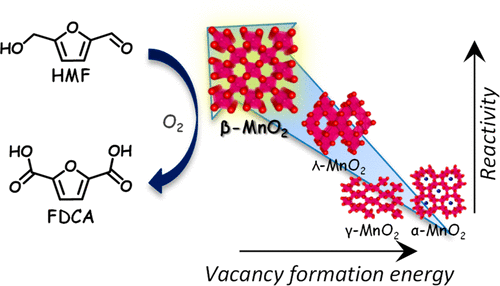当前位置:
X-MOL 学术
›
J. Am. Chem. Soc.
›
论文详情
Our official English website, www.x-mol.net, welcomes your
feedback! (Note: you will need to create a separate account there.)
Effect of MnO2 Crystal Structure on Aerobic Oxidation of 5-Hydroxymethylfurfural to 2,5-Furandicarboxylic Acid
Journal of the American Chemical Society ( IF 14.4 ) Pub Date : 2019-01-07 , DOI: 10.1021/jacs.8b09917 Eri Hayashi , Yui Yamaguchi , Keigo Kamata , Naoki Tsunoda , Yu Kumagai , Fumiyasu Oba , Michikazu Hara
Journal of the American Chemical Society ( IF 14.4 ) Pub Date : 2019-01-07 , DOI: 10.1021/jacs.8b09917 Eri Hayashi , Yui Yamaguchi , Keigo Kamata , Naoki Tsunoda , Yu Kumagai , Fumiyasu Oba , Michikazu Hara

|
Aerobic oxidation of 5-hydroxymethylfurfural (HMF) to 2,5-furandicarboxylic acid (FDCA) as a bioplastics monomer is efficiently promoted by a simple system based on a nonprecious-metal catalyst of MnO2 and NaHCO3. Kinetic studies indicate that the oxidation of 5-formyl-2-furancarboxylic acid (FFCA) to FDCA is the slowest step for the aerobic oxidation of HMF to FDCA over activated MnO2. We demonstrate through combined computational and experimental studies that HMF oxidation to FDCA is largely dependent on the MnO2 crystal structure. Density functional theory (DFT) calculations reveal that vacancy formation energies at the planar oxygen sites in α- and γ-MnO2 are higher than those at the bent oxygen sites. β- and λ-MnO2 consist of only planar and bent oxygen sites, respectively, with lower vacancy formation energies. Consequently, β- and λ-MnO2 are likely to be good candidates as oxidation catalysts. On the other hand, experimental studies reveal that the reaction rates per surface area for the slowest step (FFCA oxidation to FDCA) decrease in the order of β-MnO2 > λ-MnO2 > γ-MnO2 ≈ α-MnO2 > δ-MnO2 > ε-MnO2; the catalytic activity of β-MnO2 exceeds that of the previously reported activated MnO2 by three times. The order is in good agreement not only with the DFT calculation results, but also with the reduction rates per surface area determined by the H2-temperature-programmed reduction measurements for MnO2 catalysts. The successful synthesis of high-surface-area β-MnO2 significantly improves the catalytic activity for the aerobic oxidation of HMF to FDCA.
中文翻译:

MnO2 晶体结构对 5-羟甲基糠醛好氧氧化制 2,5-呋喃二甲酸的影响
基于 MnO2 和 NaHCO3 的非贵金属催化剂的简单系统可有效促进 5-羟甲基糠醛 (HMF) 有氧氧化为 2,5-呋喃二甲酸 (FDCA) 作为生物塑料单体。动力学研究表明,将 5-甲酰基-2-呋喃甲酸 (FFCA) 氧化为 FDCA 是将 HMF 通过活化的 MnO2 有氧氧化为 FDCA 的最慢步骤。我们通过结合计算和实验研究证明 HMF 氧化为 FDCA 在很大程度上取决于 MnO2 晶体结构。密度泛函理论 (DFT) 计算表明,α-和γ-MnO2 中平面氧位点的空位形成能高于弯曲氧位点的空位形成能。β- 和 λ-MnO2 分别仅由平面和弯曲的氧位点组成,具有较低的空位形成能。最后,β-和λ-MnO2 可能是作为氧化催化剂的良好候选物。另一方面,实验研究表明,最慢步骤(FFCA 氧化为 FDCA)的单位表面积反应速率按β-MnO2 > λ-MnO2 > γ-MnO2 ≈ α-MnO2 > δ-MnO2 > ε-MnO2;β-MnO2 的催化活性是之前报道的活化 MnO2 的三倍。该顺序不仅与 DFT 计算结果一致,而且与由 H2 程序升温还原测量确定的 MnO2 催化剂单位表面积的还原率一致。高表面积β-MnO2的成功合成显着提高了HMF有氧氧化为FDCA的催化活性。实验研究表明,最慢步骤(FFCA 氧化为 FDCA)的单位表面积反应速率按β-MnO2 > λ-MnO2 > γ-MnO2 ≈ α-MnO2 > δ-MnO2 > ε-MnO2 的顺序降低;β-MnO2 的催化活性是之前报道的活化 MnO2 的三倍。该顺序不仅与 DFT 计算结果一致,而且与由 H2 程序升温还原测量确定的 MnO2 催化剂单位表面积的还原率非常一致。高表面积β-MnO2的成功合成显着提高了HMF有氧氧化为FDCA的催化活性。实验研究表明,最慢步骤(FFCA 氧化为 FDCA)的单位表面积反应速率按β-MnO2 > λ-MnO2 > γ-MnO2 ≈ α-MnO2 > δ-MnO2 > ε-MnO2 的顺序降低;β-MnO2 的催化活性是之前报道的活化 MnO2 的三倍。该顺序不仅与 DFT 计算结果一致,而且与由 H2 程序升温还原测量确定的 MnO2 催化剂单位表面积的还原率一致。高表面积β-MnO2的成功合成显着提高了HMF有氧氧化为FDCA的催化活性。β-MnO2 的催化活性是之前报道的活化 MnO2 的三倍。该顺序不仅与 DFT 计算结果一致,而且与由 H2 程序升温还原测量确定的 MnO2 催化剂单位表面积的还原率一致。高表面积β-MnO2的成功合成显着提高了HMF有氧氧化为FDCA的催化活性。β-MnO2 的催化活性是之前报道的活化 MnO2 的三倍。该顺序不仅与 DFT 计算结果一致,而且与由 H2 程序升温还原测量确定的 MnO2 催化剂单位表面积的还原率一致。高表面积β-MnO2的成功合成显着提高了HMF有氧氧化为FDCA的催化活性。
更新日期:2019-01-07
中文翻译:

MnO2 晶体结构对 5-羟甲基糠醛好氧氧化制 2,5-呋喃二甲酸的影响
基于 MnO2 和 NaHCO3 的非贵金属催化剂的简单系统可有效促进 5-羟甲基糠醛 (HMF) 有氧氧化为 2,5-呋喃二甲酸 (FDCA) 作为生物塑料单体。动力学研究表明,将 5-甲酰基-2-呋喃甲酸 (FFCA) 氧化为 FDCA 是将 HMF 通过活化的 MnO2 有氧氧化为 FDCA 的最慢步骤。我们通过结合计算和实验研究证明 HMF 氧化为 FDCA 在很大程度上取决于 MnO2 晶体结构。密度泛函理论 (DFT) 计算表明,α-和γ-MnO2 中平面氧位点的空位形成能高于弯曲氧位点的空位形成能。β- 和 λ-MnO2 分别仅由平面和弯曲的氧位点组成,具有较低的空位形成能。最后,β-和λ-MnO2 可能是作为氧化催化剂的良好候选物。另一方面,实验研究表明,最慢步骤(FFCA 氧化为 FDCA)的单位表面积反应速率按β-MnO2 > λ-MnO2 > γ-MnO2 ≈ α-MnO2 > δ-MnO2 > ε-MnO2;β-MnO2 的催化活性是之前报道的活化 MnO2 的三倍。该顺序不仅与 DFT 计算结果一致,而且与由 H2 程序升温还原测量确定的 MnO2 催化剂单位表面积的还原率一致。高表面积β-MnO2的成功合成显着提高了HMF有氧氧化为FDCA的催化活性。实验研究表明,最慢步骤(FFCA 氧化为 FDCA)的单位表面积反应速率按β-MnO2 > λ-MnO2 > γ-MnO2 ≈ α-MnO2 > δ-MnO2 > ε-MnO2 的顺序降低;β-MnO2 的催化活性是之前报道的活化 MnO2 的三倍。该顺序不仅与 DFT 计算结果一致,而且与由 H2 程序升温还原测量确定的 MnO2 催化剂单位表面积的还原率非常一致。高表面积β-MnO2的成功合成显着提高了HMF有氧氧化为FDCA的催化活性。实验研究表明,最慢步骤(FFCA 氧化为 FDCA)的单位表面积反应速率按β-MnO2 > λ-MnO2 > γ-MnO2 ≈ α-MnO2 > δ-MnO2 > ε-MnO2 的顺序降低;β-MnO2 的催化活性是之前报道的活化 MnO2 的三倍。该顺序不仅与 DFT 计算结果一致,而且与由 H2 程序升温还原测量确定的 MnO2 催化剂单位表面积的还原率一致。高表面积β-MnO2的成功合成显着提高了HMF有氧氧化为FDCA的催化活性。β-MnO2 的催化活性是之前报道的活化 MnO2 的三倍。该顺序不仅与 DFT 计算结果一致,而且与由 H2 程序升温还原测量确定的 MnO2 催化剂单位表面积的还原率一致。高表面积β-MnO2的成功合成显着提高了HMF有氧氧化为FDCA的催化活性。β-MnO2 的催化活性是之前报道的活化 MnO2 的三倍。该顺序不仅与 DFT 计算结果一致,而且与由 H2 程序升温还原测量确定的 MnO2 催化剂单位表面积的还原率一致。高表面积β-MnO2的成功合成显着提高了HMF有氧氧化为FDCA的催化活性。

































 京公网安备 11010802027423号
京公网安备 11010802027423号